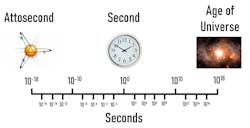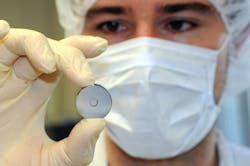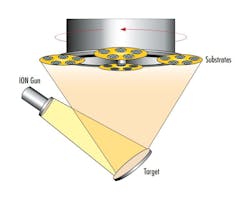Attosecond extreme ultraviolet lasers demand high-precision multilayer mirrors
The development of laser pulses with attosecond (asec) pulse durations, during the past few decades, provides a window into electron dynamics previously inaccessible to laser systems—even on a femtosecond timescale.
First generated in 2001 by M. Hentschel et al., laser pulses with asec pulse durations—where 1 asec = 10-18 sec—provide access to some of the most fundamental scientific processes, including the motion of electrons.1 To put the duration of attosecond pulses into perspective, one attosecond is to one second as one second is to the age of the universe (see Fig. 1).2
Today, the shortest generated laser pulses are less than 100 asec (43 asec, as of 2017), which is comparable to the ground-state orbital period of an electron within hydrogen.3 All ultrafast lasers are characterized by their short pulse durations, and attosecond lasers push the lower boundaries of pulse duration for ultrafast lasers. Observations of electron localization, the dynamics of decay processes, and the effects of strong fields are just a few of the major findings of the newly established field of attosecond science.4-6
Generating attosecond laser pulses
Generating a propagating ultrafast laser pulse requires both sufficient bandwidth and an appropriate center wavelength. Spectral bandwidth determines the minimum possible pulse duration, which is governed by the Fourier transform relationship. In principle, broader spectral bandwidths support shorter pulses. In practice, an infinitely broad spectrum cannot be generated to produce a laser pulse with an infinitely short pulse duration.
The optical cycle, or the period of the laser pulse’s center wavelength, limits the duration as well. This quantity can be obtained by dividing the center wavelength by the speed of light; for a pulse centered at 800 nm, the optical cycle is approximately 2.67 fs. From this result, a laser pulse centered at 800 nm clearly cannot support compression to attosecond pulse durations, even if the spectral bandwidth is sufficiently large. On the other hand, a pulse centered at 19 nm would have a minimum duration of about 63 asec. For this reason, attosecond laser pulses are typically in the EUV (also known as XUV) region of the electromagnetic spectrum and cannot be generated at lower energy regions (longer wavelengths).
Attosecond laser sources
The most common sources of EUV attosecond pulses are free-electron lasers (FELs) and high- harmonic generation (HHG), where the latter is typically more accessible to the average laser user. The widely accepted description for attosecond generation via HHG is a three-step model in which the sample, typically a noble gas, first interacts with the strong electric field provided by the laser. The applied field distorts the Coulomb potential that governs the electronic wave function and induces ionization of the sample via tunneling. The electron is accelerated away from the parent ion by the electric field provided by the laser, but then accelerated toward the parent ion when the oscillating field reverses. As the electron recombines with its parent ion, the kinetic energy it gained during acceleration is released in the form of photons at odd harmonics of the driving laser frequency.7
Optics for attosecond extreme ultraviolet lasers
Attosecond EUV applications inherently have very demanding requirements for the optical components used in them. High-precision, metallic/dielectric multilayer mirrors are typically used for steering, focusing, and shaping attosecond pulses (see Fig. 2). Attosecond optics should be designed for maximum control of the central wavelength/energy, spectral shape, spectral phase, and pulse duration.Attosecond experiments require incredibly well-synchronized laser pulses. Because coherent EUV/soft x-ray sources are limited in their tunability, this must be addressed by pulse-shaping attosecond optics such as laser mirrors. Optics not angle-dependent or chromatically dispersive are preferred, as these effects broaden the pulse in the time domain. Multilayer mirrors are better suited than other components such as gratings to meet these needs. High multilayer coating accuracy on the reflective surfaces is necessary to maintain desired pulse characteristics, and super-polished substrates with surface roughness on the order of 1 Å (10-10 m) are typically desired to minimize light loss due to scattering. Advanced simulation and optimization of the amplitude and phase characteristics of the multilayer mirror coatings are done before depositing coating layers.
Atomically thin multilayer coatings for attosecond EUV laser mirrors can be deposited using a variety of different deposition techniques including chemical vapor deposition, pulsed laser deposition, magnetron sputtering, and electron-beam evaporation. The latter two techniques are more commonly used. The highest-recorded EUV normal incidence reflectivity of 70.9% was achieved on mirrors coated by magnetron sputtering.8 But the highest level of coating control and reproducibility is achieved by ion-beam deposition, also known as ion-beam sputtering.
Ion-beam deposition is a powerful tool for a precise thickness control, without the need for in situ thickness monitoring (see Fig. 3). The ion energy and current can be controlled independently to increase the degrees of freedom for optimizing the layer growth.EUV attosecond mirrors are typically measured using white-light spectral ellipsometry, EUV/soft x-ray reflectometry, and grazing incidence hard x-ray reflectometry. White-light spectral ellipsometry is a comprehensive measurement technique that makes use of phase and amplitude modulation of radiation upon reflection off a sample at a fixed angle of incidence.
Ellipsometry can therefore be used for in situ measurements to analyze multilayer samples during deposition and determine the needed deposition rates. EUV/soft x-ray reflectometry provides an absolute reflectivity measurement of a multilayer mirror at a certain angle of incidence, and grazing incidence hard x-ray reflectometry reveals information about the roughness of coating layers, which plays an important role in the mirror's reflectivity. Combining all of this information creates a comprehensive model for theoretical and real performance of the EUV attosecond-multilayer mirrors.
Applications for attosecond optics
Advances in attosecond optics are facilitating growth within the field of attosecond science. Traditional ultrafast techniques such as pump-probe spectroscopy have been enhanced by the features of attosecond pulses.
Typical configurations of pump-probe are streaking or transient absorption. Transient absorption experiments start with a visible pump laser pulse exciting the system of interest. After a defined time delay, a white-light probe pulse monitors the spectrally resolved evolution of the excited states. In the case of attosecond transient absorption spectroscopy (ATAS), a visible-near-IR pump excites the system so the attosecond EUV pulse acts as the probe. In the case of attosecond streaking, however, it is the opposite—an initial laser pulse triggers the ionization of an atom or molecule before the oscillating electric field of a second longer-wavelength laser pulse modulates the energy of the emitted electrons. The spectral resolution provided by the EUV attosecond pulse provides insight into the motions of valence electrons, as well as the dynamics of core electronic states.5,9
In the majority of attosecond experiments conducted today, the driving laser for HHG is still an amplified Ti:sapphire laser system. Techniques such as chirped-pulse amplification, for which Strickland and Mourou were awarded the Nobel Prize in Physics in 2018, along with other methods for pulse compression, provide near-single-cycle pulse durations to drive the HHG process. Unfortunately, relatively slow repetition rates associated with these lasers systems (~10 kHz, maximum) place serious limitations on the attosecond generation process, and the data acquisition times associated with complex detection schemes in attosecond experiments. As a result, there is a push toward higher-power, higher-repetition-rate laser systems within the attosecond community, which has led to the introduction of megahertz-repetition-rate EUV systems.
Recent developments have shifted from Ti:sapphire laser systems to ytterbium-based lasers centered around 1030 nm. When combined with the use of optical parametric-chirped-pulse amplifiers, which allow for both high average powers and high repetition rates, the attosecond science community is trending toward more powerful lasers for probing fundamental electronic phenomena.10
As the attosecond science community grows and these technologies become more accessible to different laser users, it is imperative for researchers to have access to optical components that support their scientific inquiries. Sourcing complex ultrafast optics, such as attosecond EUV mirrors, has traditionally been difficult because they often need to be custom designed. Prices and long lead times for small quantities are prohibitive for many, but now attosecond EUV mirrors are available as standard off-the-shelf components. This reduces the price and lead time for small quantities, which is especially important for quickly repairing broken systems, exploring new ideas quickly for system prototyping, and speeding the pace of scientific discovery.
REFERENCES
1. M. Hentschel et al., Nature, 414, 509–513 (2001); doi:10.1038/35107000.
2. D. Villeneuve, Contemp. Phys., 59, 1, 47–61 (2018); doi:10.1080/00107514.2017.1407093.
3. T. Gaumnitz et al., Opt. Express, 25, 22, 27506–27518 (2017); doi:10.1364/oe.25.027506.
4. G. Sansone et al., Nature, 465, 763–766 (2010); doi:10.1038/nature09084.
5. M. Drescher, Nature, 419, 803–807 (2002); doi:10.1364/oe.25.027506.
6. M. Lucchini et al., Science, 353, 6302 (2016); doi:10.1126/science.aag1268.
7. A. Zeidler et al., Phys. Rev. Lett., 95 (2005); doi:10.1103/physrevlett.95.203003.
8. S. Bajit et al., Proc. SPIE, 4506, 65–75 (2001); doi:10.1117/12.450946.
9. E. Goulielmakis et al., Nature, 466, 7307, 739–743 (2010); doi:10.1038/nature09212.
10. T. Witting et al., Optica, 9, 2, 145–151 (2022); doi:10.1364/optica.443521.
About the Author
Alexander Guggenmos
CEO, UltraFast Innovations
Alexander Guggenmos is chief executive officer (CEO) at UltraFast Innovations (Garching, Germany).
Olivia Wheeler
Olivia Wheeler, Ph.D., is an ultrafast laser optics engineer at Edmund Optics (Barrington, NJ).


